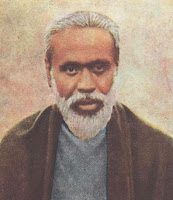The blind man sees a wonderful sight to which there is no end. The dumb man speaks wonderful speech, and the man having speech becomes dumb.
I have not seen anything, still I have seen everything! I have not heard anything, still I have heard everything!
Such is the phenomenon of Nature. This structure or creation is of three attributes: Sat, Raj and Tam.
In Tam there is Be-ing, manifestation and existence (is-ness).
In Sat there is withdrawal, latency, waning and dissolution. But one should never mistake this latency and waning (decline) as non-existence. Otherwise it would be misleading. It is only a condition, a state of withdrawal of existence. Withdrawal or waning (decline) is not non-existence.
The witness to this manifestation and withdrawal Be-ing and non-Be-ing, existence and non-existence (is-ness) is the mixed state of Raj, which is the knot of Sat and Tam, matter and spirit (conscient and inconscient).
Tam is matter, Sat is spirit and Raj is the mind (heart). This condition is in both microcosm or Pind and macrocosm or Brahmanda.
In both there is the same picture. Just as we get up in our body in the waking state, withdraw ourselves in deep-sleep, and dream in the dream state, so also there is a greater existence, Virat Astitva, which does the same acts and is engaged in doing so. The sages call this, Virat Astitva, greater existence, Brahman. The Sufis have called it Khuda-i-Azeem. The difference between the two is that of body, size and expanse. The word Jeeva should not be used for it. Jeeva is miniature creation only. That greater existence also is mind, a knot of matter and spirit. People fear to say it clearly.
That greater existence, Brahman is (i) a knot of matter and spirit, (ii) a mixed condition of Sat, Tam and Raj, (iii) It wakes, sleeps and merges like us, (iv) It acts as we do, (v) Of course it is big while we are small, (vi)It is unlimited, omniscient, omnipresent and all pervading, whereas we have these qualities in a very limited degree. This is the difference. Our name is individual soul, Jeeva, whereas His name is Cosmic spirit, Brahman. The sages gave Him this name because they understood its meaning thoroughly well. Just think of the meaning of the word Brahman for a moment. Bruhat + man i.e. Big mind — one having a big mind is Brahman. The Sufis did not know Him by this name. As they did not find other better words they called Him as 'Khuda-i-Azam'. But they too had brains to understand hints or signs. It is the mind alone that can think. But the word Brahman means big or one that grows big. The passage of time brought about this change in the meaning. So the cosmic mind is Brahman and individual mind is Jeeva. It is heavenly mind, and this is earthly mind. It is one and these are many. It is the sum total of all, these are separate pieces. The Jiva is stupid and ignorant. The Jiva can remain fickle in spite of its becoming gnostic (wise – Jnani). Brahman is stupid and ignorant. He is gnostic and fickle. If these qualities were not found in Him, they would not have been found in Jiva also.
The Brahman, too, has body. When He is called Cosmic Mind, the mind itself becomes a body. How can it be devoid of the qualities of the body? This material body of yours is gross body. All this creation or universe is the gross body of the Brahman, from the point of view of matter (substance). This mind is your subtle body. The knot formed by the sum total of the ideas of this creation is the subtle body of the) Brahman. This soul, the true place of repose, the seed, is your causal body. The base on which the entire universe rests, or the seed of the state of merger in the Brahman, is the causal body of the Brahman. These are the forms of both. They must also be having names.
The Jiva which is related to the gross body is termed Vishwa in the Scriptures, the suggestive meaning of which is earthly. The Jiva which is related to the subtle body or mind is called Taijas in .the scriptures, the suggestive meaning of which is fickle. The Jiva related to the soul or causal body is called Prajna in the scriptures, which can be roughly translated as peace. The meaning of Prajna in this context is not 'wise' (gnostic). The soul or the causal body has no knowledge in it. These are the names of the Jiva related to the three kinds of bodies. Now the names of the Brahman are as follows:
(1) The Brahman related to the gross body is called Virat in the scriptures, the meaning of which can be suggested by the word ‘voice of a high pitch’.
(2) The Brahman related to the subtle body is called Avyakrita or ‘pervading’ (Antaryami) in the scriptures. The meaning of Antaryami is conveyed by the word ‘internal journey’. The meaning of Avyakrita is suggested by the idea ‘ the Invisible Doer.’
(3) The Brahman related to the causal body is called Hiranya Garbha in the Shastras, the meaning of which is suggested by the words ‘lying peacefully or steadily in the form of golden egg’. Here also wisdom or knowledge is not concerned.
These are the names of the Brahman in relation to the three bodies from the point of view of Jivas. The Cosmic mind, or the heart of creation of the Universe, is called Brahman, and the terminology in respect of your mind, too, is the same.

No comments:
Post a Comment